5 Access strategies for students with disabilities
Student Voice
These three videos share the stories of three students, including the barriers they face, and what helps make teaching and learning more accessible. When you click on each video, it will open in a new tab.
Tomi (6:12)
Dawson (3:54)
Michelle (6:53)
Reflect:
- What key messages will you take away from these videos?
- What supports or enablers helped to make learning environments more accessible and inclusive?
Each student is an individual, and some will need individual accommodations and considerations — even in a classroom where UDL is implemented. It’s important to work with accessibility services and with the student to determine what they need at this specific time.
Students’ needs can also change, depending on the course, their health, or even the time of year. Students can be experts on their own disabilities — remember that you might not know the whole story. Trust students to know what they need. Alternatively, some students need support to learn how to articulate their needs, based on their own experiences and documentation. The postsecondary environment is a great place for them practice self-advocacy skills.
Listen to and learn from your students. Be creative and flexible. Know that what works for one student with ADHD, for example, may not work for another. Some students live with more than one disability, and you may not even know what disability a student has or even which students in your class need accommodations.
In the 2017 Canadian Survey on Disability [1](CSD), Statistics Canada describes 10 disability types:
- Seeing
- Hearing
- Mobility
- Flexibility
- Dexterity
- Pain-related
- Learning
- Developmental
- Mental health-related
- Memory
No list can cover the many different experiences of disability, and no inventory of accommodations will cover every student need.
How is this section organized?
In this section, we use personas to introduce you to some barriers students with disabilities experience in higher education. Each persona is based on actual students, but is not about one particular student. [2]
First, strategies that support all students are listed. These strategies can make learning more accessible to students with a wide range of disabilities, as well as students who may not identify as having a disability but still benefit from increased access. Second, strategies that support students with some specific disabilities — including physical disabilities that limit mobility, as well as hearing and vision loss — are listed.
Persona: Bella
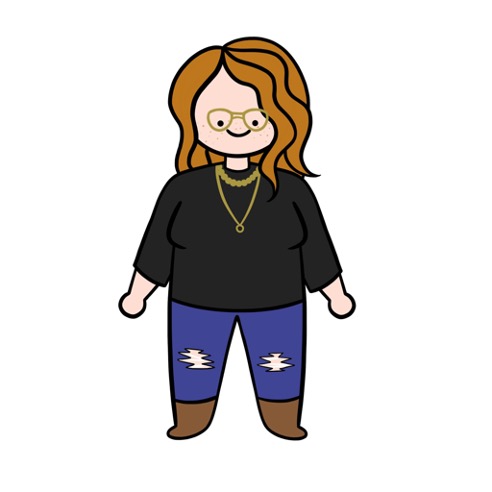
Bella is an 18-year-old woman in her first year at community college. She is very artistically talented and creates art using both traditional and digital tools. Bella was diagnosed as autistic at 16 and is still learning to advocate for herself. She needs more time to process information and contribute to a discussion, and does not make social connections easily. She lives at home with her parents.
Ability: Autistic with graphomotor processing learning disability, which means taking notes from verbal lectures is very difficult.
Strengths: Strong visual and artistic skills, verbal and written communication skills, and the ability to focus intensely on topics and projects that interest her. Intermediate laptop and advanced tablet user.
Challenges: Executive functioning and organization; may have trouble following multi-step instructions, especially if they are delivered only verbally; note-taking; keeping up with and participating in class discussion; connecting with peers.
Attitude: Loves to learn, but has had negative experiences in school.
Assistive technology: Laptop for note-taking in class.
What helps:
- Having lecture notes provided online
- Providing information in multiple formats: Written and verbal
- Class discussions structured so each student has a chance to take part
- The option to work individually instead of in a group
- Detailed course outlines and assignment instructions
Persona: Bria
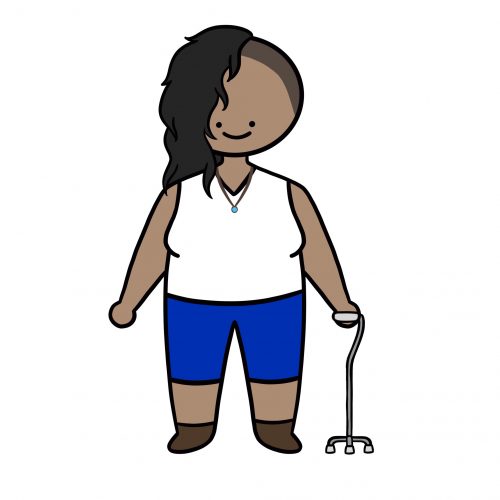
Bria is a 21-year-old queer student. She experiences chronic migraine, which causes her varying amounts of head pain everyday, along with brain fog and fatigue. She was diagnosed 5 years ago and symptoms are steadily worsening. She recently started using a cane to mitigate fatigue.
Strengths: Very motivated to succeed in school. Excellent communicator.Ability: Experiences chronic pain due to migraines.
Challenges: Can’t always attend class due to chronic pain. Environmental triggers such as bright lights and strong perfumes trigger her migraines. She uses a cane to mitigate fatigue, which makes her more visibly disabled.
Attitude: Strong advocate for herself; loves school and wants to succeed, but needs to balance pushing herself in the moment with longer-term impacts.
Assistive technology: N/A
What helps:
- Having a note-taker
- Online options and flexibility
- Fully physically accessible spaces free of obstructions
- Operating elevators that do not require a key or permission to use them
- Not having to explain her disability and her needs over and over
- Lowered lights, option to take breaks from class
Persona: Melanie
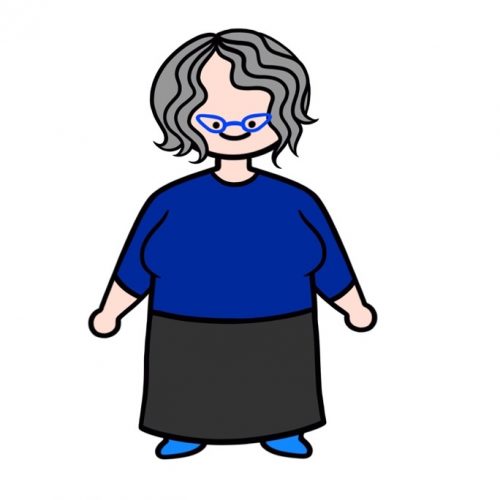
Melanie is 52, a mature student with two adult children. She’s in her third year of an English degree. Melanie is creative, loves to write, and is hoping to write for magazines once she graduates. She’s a part-time student and works 20 hours a week in a bank, so it’s taking her several years to finish her degree. She lives in the suburbs and commutes 45 minutes to and from campus three times a week.
Ability: Bipolar 2 disorder, which in Melanie’s case causes depression, anxiety, and fatigue; as well as ADHD.
Strengths: Knows her strengths and challenges, and perseveres when things are difficult. Very strong communication and social skills, and appears to have everything “under control”.
Challenges: Struggles with class attendance and meeting deadlines; may need more time to complete tasks; distractible; reading can be difficult; needs to move around during class; feels left out and stigmatized by assumptions about mental illness, and tired of having to explain her challenges and justify her need for accommodations.
Attitude: Hardworking and serious about her studies, perfectionistic, and sometimes frustrated by her challenges.
Assistive technology: Laptop with screen reading technology
What helps:
- Flexibility about assignment deadlines
- Additional time for tests and exams
- Alternative assignment and assessment options
- Permission to record lectures
- Having lecture notes available online
- A quiet place in class or close by for doing in-class work
- Freedom to leave or move around the classroom
- Freedom to turn her camera off during online classes
- Not having to repeatedly explain her disability and accommodations
Creating accessible learning environments for students with many types of disabilities — and ALL students
- Be clear in your syllabus, with firm due dates and well-defined expectations.
- Provide digital course notes, slide decks, and other materials — before class if possible.
- Briefly review material from your previous class before starting new material.
- Review new learning objectives.
- Summarize important points at the end of class.
- Provide instructions and reminders in different formats: verbal, written, video, and audio.
- Be patient when you communicate. Listen and give students time to process and respond.
- Don’t make assumptions about what people can or can’t do.
- Speak directly to the person with a disability and not to their support person, companion, or interpreter.
- Be flexible and offer options for assignments and assessments. Allow students to use their strengths.
- Encourage students to create study groups and share class notes.
- Trust students to know when they need a break from class.
- Help identify tutors and/or note takers.
- Reserve seating at the front of the room or close to the door.
- Allow audio recorders and note-taking on a laptop.
- Lean towards flexibility for absences and late or forgotten assignments.
- Familiarize yourself with and deploy adaptive technologies.
- Talk with the student about their learning needs, strategies for success, alternatives to course assignments, and methods of evaluation.
For tests, exams, and assessments
- Point out the important sections in course plans, textbooks, and readings.
- Provide sample tests and exams.
- Offer additional time.
- Allow computers, calculators, dictionaries, and spell-check.
- Offer alternatives to traditional methods of evaluation.
- Provide a quiet space or distraction-reduced environment.
- Allow memory aids for formulas or definitions.
- Consider minimal deductions for spelling and grammar mistakes, and give partial marks for demonstrating understanding without a correct answer.
- Allow students to eat, drink, and attend to physical needs.
- Ensure all tests are fully accessible, including graphic content.
- Offer alternatives for students to demonstrate their competencies, such as an oral presentation instead of a written assignment or timed test.
- Allow text-to-speech or speech-to-text software
- Offer large print or electronic format or coloured paper
- Include scribes (French and English)
- Talk with the student about their learning needs, strategies for success, alternatives to course assignments, and methods of evaluation.
Creating accessible learning environments for students with specific types of disabilities
These strategies are grouped by disability type, but many will improve access for a range of students. For example: Students who have auditory processing difficulties or speak English as an additional language will also benefit from closed captioning or subtitles.
Persona: Jack
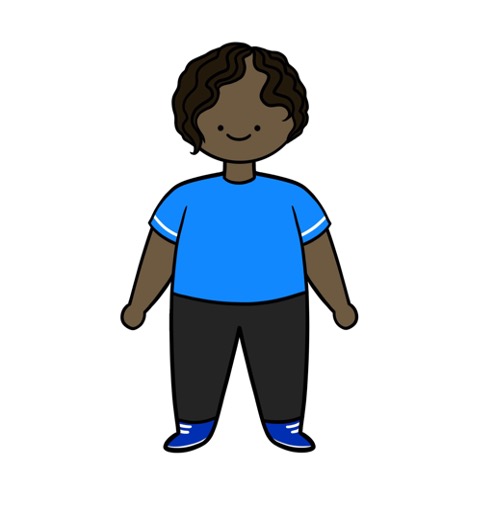
Jack is a 24-year-old in their third year of a business degree. They are entrepreneurial and interested in starting their own human resource consulting business after graduation. They enjoy participating in business case competitions with a team of students. Jack has hearing loss and wears hearing aids. They live in residence.
Ability: Has hearing loss and lives with depression and anxiety. Can speak both English and ASL, read lips, and requires ASL interpretation in class and in large-group situations like presentations.
Strengths: Excellent organizational, presentation, and group work skills. Advanced technology user.
Challenges: Hearing verbal information, especially in a large group or when there is ambient noise; and participating in group work or discussion if proper interpretation and technology is not available.
Attitude: Strong self-advocate; supports other students with disability advocacy; strong academic student.
Assistive technology: Laptop for note-taking in class; closed captioning.
What helps:
- Having lecture notes provided online, and all instructions in written form
- Instructor facing the class when speaking
- Instructor using a microphone and speakers in class
- Providing slide decks with ASL interpretation
- Ensuring ASL interpretation is available when possible, and that the other members of the class understand the etiquette of interpretation.
Creating accessible learning environments for students who are Deaf or have hearing loss
- Provide visuals like tables, images, and graphs, and use slide decks and videos with captions.
- Turn off unused equipment to eliminate background noise.
- Speak at a regular pace, facing the class, as clearly and distinctly as possible.
- Mark students’ written work based on quality of content, not grammatical error rate.
- Find a quiet place to talk with students.
- Do not put your hands, glasses, or other objects like pens or pencils in front of your face when speaking.
- Repeat questions and comments from the class before responding.
- Help identify note-takers.
- Communicate in writing with the student, and book an interpreter if needed.
- Talk with the student about their learning needs, strategies for success, alternatives to course assignments, and methods of evaluation.
- Turn on closed captions for any video content.
“When the student is accompanied by interpreters:
- Meet with both the student and the interpreter to discuss accommodations.
- Provide interpreters with brief course outlines.
- Allow interpreters to sit or stand near you so the student can watch you and “read your words” at the same time.
- Watch the student but listen to the interpreter when they are relaying what the student is saying. When you speak, look at and address the student, not the interpreter.
- Take short breaks in your speaking to allow the interpreter to catch up. Plan a 10-minute break for every 50 minutes of class presentation.
- Make sure there’s enough light for the Deaf student to see the interpreter, and that they can see both the interpreter and any visual presentation simultaneously.”[3]
Persona: Abdullah
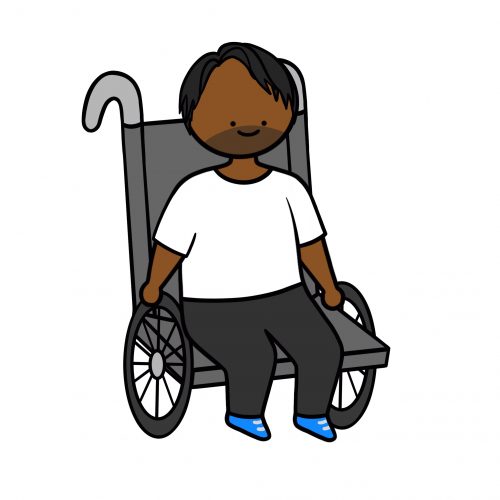
Abdullah is 22, pursuing a Bachelor of Education, and planning to teach elementary school. He has a busy social life on campus and is involved in student government. Abdullah uses a wheelchair due to an acquired spinal cord injury and lives in an apartment off-campus.
Ability: Paraplegic, and uses a manual wheelchair.
Strengths: Academically accomplished and is active in several extracurricular activities on campus, including volunteering at the accessibility centre. Advanced technology user.
Challenges: Requires the built environment throughout campus to be accessible, including buildings, bathrooms, classrooms, equipment, materials, etc. Has to accommodate medical appointments, rest and recovery time from periodic medical procedures, and the high cost of medical supplies.
Attitude: Ambitious and serious student who is clear about what he needs.
Assistive technology: N/A
What helps:
- Fully accessible physical environments, including bathrooms
- Appropriate furnishings and room set-up
- Operating elevators that do not require a key or permission to use them
- Flexibility about assignment deadlines
- Freedom to leave the classroom or exam room as needed
- Field trips to accessible locations, with accessible transportation
- Inclusive language
Creating accessible learning environments for students with physical disabilities
- Ensure your classroom, laboratory, and equipment are physically accessible and be prepared to change locations if not.
- Ensure the furnishings are appropriate and do not obstruct mobility.
- Some students may not be able to raise a hand; make eye contact to include the student in classroom discussions.
- When talking for more than a few moments to a student who uses a wheelchair, sit down, kneel, or squat if you can.
- A person’s assistive device — wheelchair, walker, etc. — is part of their personal space. Do not hang or lean on it, or push a wheelchair without asking.
- Plan field trips for accessible locations, with all students’ needs in mind. Build in extra time for the activity and for transportation.
- Talk with the student about their learning needs, strategies for success, alternatives to course assignments, and methods of evaluation.
Persona: Ify
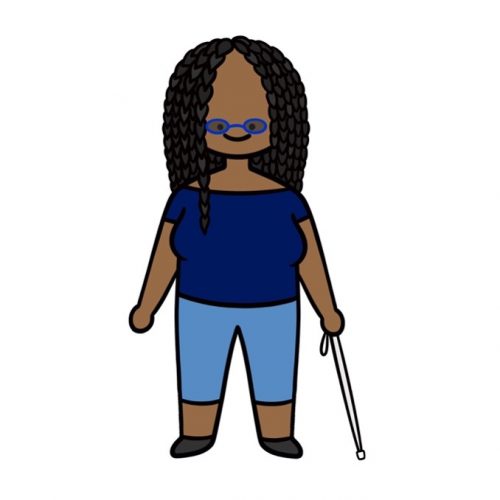
Ify is a 30-year-old international grad student from Nigeria pursuing a law degree. She is independent, energetic, outspoken, and is well-known on campus as a disability activist. Ify is partially sighted and uses a white cane. She also has hearing loss and notes the difference between her visible and invisible disabilities and how others treat her as a result. She lives off campus.
Ability: Is partially sighted and has hearing loss.
Strengths: Excellent communicator with high emotional intelligence, a leader. Intermediate technology user.
Challenges: Can’t read paper handouts or attendance lists; has difficult hearing in a large group or when there is ambient noise; navigating inaccessible buildings and infrastructure. Has experienced social stigma, bullying, and often feels unwelcome or like she “doesn’t fit in” on campus.
Attitude: Strong advocate for herself and other students; loves school and wants to focus on learning, not fighting for accommodations and inclusion.
Assistive technology: Laptop; closed captioning; screen readers.
What helps:
- Good lighting in class
- Instructor facing the class when speaking, and verbally explaining any visual materials
- Instructor using a microphone and speakers in class
- Providing content in multiple formats: electronic, audio, large print, etc.
- Having a note-taker
- Fully physically accessible spaces free of obstructions
- Not having to explain her disability and her needs over and over
Creating accessible learning environments for students who are blind or have vision loss
- Provide the course outline, reading list, slide decks, etc., digitally and in a format suitable for screen reading software.
- Provide print-only material in a screen reader-friendly format, or far enough in advance to ensure that transcription requirements (into audio-digital, enlarged format, or Braille) can be met in time.
- Explain verbally any graphs or charts used in class.
- Read aloud all material written on the board and explain what you’re doing when you gesture or point things out.
- Use effective contrast for handouts printed on white paper.
- Provide clear and concise instructions, and repeat them regularly.
- Pair the student with a suitable sighted lab partner.
- Discuss lab safety with the student and with accessibility services.
- If the student reads Braille, have lab equipment tagged in Braille.
- Talk with the student about their learning needs, strategies for success, alternatives to course assignments, and methods of evaluation.
A word on service animals:
- Do not talk to, pet, feed, or offer treats to a service animal. Invite the student to explain the rules about their animal to the class, or offer to do it yourself.
- The owner is responsible for maintaining control over the animal at all times.
- Service animals are permitted in all areas on campus to which the public normally has access, with only a few exceptions, such as food prep areas or situations where another person has severe allergies.
- Statistics Canada. (2018). Canadian Survey on Disability, 2017. https://www150.statcan.gc.ca/n1/daily-quotidien/181128/dq181128a-eng.htm ↵
- Illustration Credit: Persona images created by Bea van Leeuwen shared under a CC BY-SA license. ↵
- Ontario's Universities Accessible Campus. Welcome to COU's Accessibility Resources Website. https://accessiblecampus.ca/ ↵
Braille is a tactile system of raised dots used by many people who are blind or partially sighted. Each raised dot arrangement represents a letter or word combination that is read by touch.

